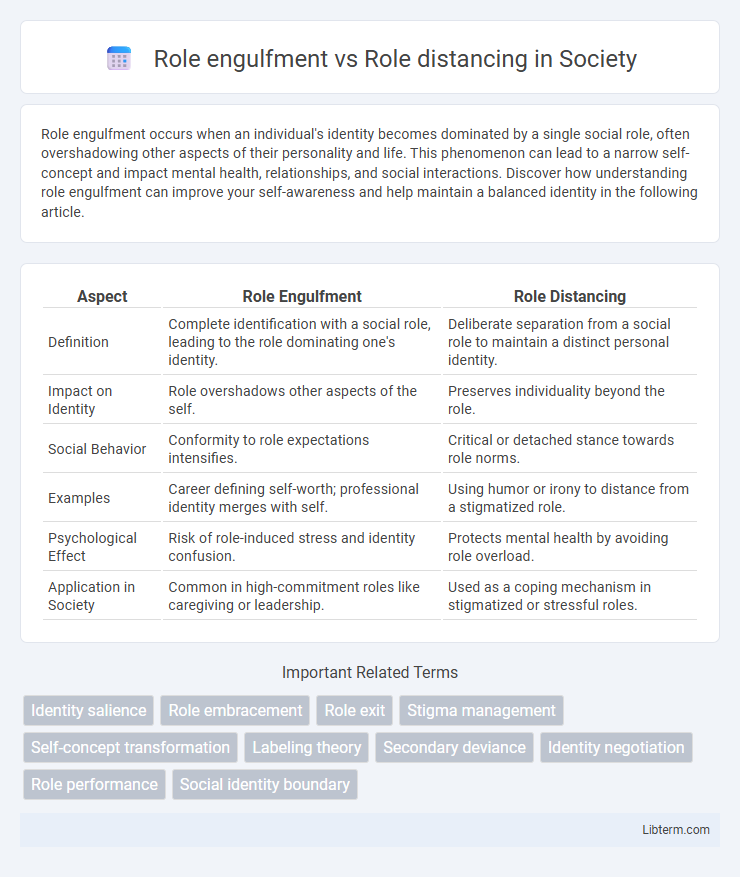Role engulfment occurs when an individual's identity becomes dominated by a single social role, often overshadowing other aspects of their personality and life. This phenomenon can lead to a narrow self-concept and impact mental health, relationships, and social interactions. Discover how understanding role engulfment can improve your self-awareness and help maintain a balanced identity in the following article.
Table of Comparison
| Aspect | Role Engulfment | Role Distancing |
|---|---|---|
| Definition | Complete identification with a social role, leading to the role dominating one's identity. | Deliberate separation from a social role to maintain a distinct personal identity. |
| Impact on Identity | Role overshadows other aspects of the self. | Preserves individuality beyond the role. |
| Social Behavior | Conformity to role expectations intensifies. | Critical or detached stance towards role norms. |
| Examples | Career defining self-worth; professional identity merges with self. | Using humor or irony to distance from a stigmatized role. |
| Psychological Effect | Risk of role-induced stress and identity confusion. | Protects mental health by avoiding role overload. |
| Application in Society | Common in high-commitment roles like caregiving or leadership. | Used as a coping mechanism in stigmatized or stressful roles. |
Understanding Role Engulfment
Role engulfment occurs when an individual's identity becomes overwhelmingly defined by a single role, leading to a diminished sense of self outside that role. This phenomenon often results in rigid behavior patterns and difficulty adapting to new social contexts, as the person's self-concept is deeply intertwined with specific expectations and responsibilities. Understanding role engulfment is crucial for recognizing how social interactions and external perceptions can significantly influence personal identity and mental health.
Defining Role Distancing
Role distancing refers to the conscious effort individuals make to separate themselves from the expectations and behaviors associated with a particular social role, often to maintain a sense of personal identity beyond the role. This concept highlights how people resist full internalization of a role by displaying detachment or disengagement, preventing role engulfment, where the role dominates one's self-concept. Role distancing is essential in social interactions to navigate multiple roles without losing individuality or experiencing role strain.
Psychological Foundations of Role Theory
Role engulfment occurs when an individual's identity becomes dominated by a single social role, leading to a loss of personal autonomy and role differentiation. Role distancing involves deliberately separating oneself from a social role to preserve self-identity and resist role expectations. Psychological foundations of role theory emphasize how social cognition, identity formation, and self-concept interact to influence the extent of role commitment and distancing behaviors.
Key Differences Between Role Engulfment and Role Distancing
Role engulfment occurs when an individual's identity becomes overwhelmingly defined by a specific social role, leading to a loss of other personal identities. In contrast, role distancing involves maintaining a psychological separation from a role, allowing the person to avoid being completely identified with it. The key difference lies in the extent of identity fusion; role engulfment results in deep role integration, while role distancing preserves personal identity autonomy.
Causes of Role Engulfment
Role engulfment occurs when an individual's identity becomes dominated by a single social role, often due to prolonged immersion or external labeling that reinforces this identity. Causes include intense social expectations, stigmatization, and limited opportunities for alternative role exploration, leading to a narrowed self-concept. Persistent role engulfment impacts personal behavior and social interactions, reducing the flexibility to adopt diverse roles.
Motivations for Role Distancing
Role distancing occurs when individuals deliberately separate themselves from the behaviors, attitudes, or expectations associated with a social role to maintain a positive self-image or avoid stigma. Motivations for role distancing include preserving personal identity, reducing role-related stress, and managing social judgment or negative stereotypes linked to the role. This behavior helps individuals assert autonomy and resist role engulfment, where the role would otherwise dominate their self-concept.
Impact on Personal Identity
Role engulfment occurs when an individual's identity becomes dominated by a single social role, leading to a loss of a multifaceted sense of self and increased vulnerability to role-based stigma. Role distancing involves maintaining a separation between one's self-concept and the social role, which helps preserve personal identity and reduces the psychological burden of negative role stereotypes. The dynamic between these processes significantly influences how individuals negotiate self-esteem, social integration, and overall mental health.
Social Consequences and Relationships
Role engulfment occurs when an individual's identity becomes dominated by a specific social role, often leading to a loss of personal autonomy and strained relationships due to others perceiving them primarily through that role. Role distancing involves deliberately minimizing or detaching from a role to maintain a broader self-concept and preserve social flexibility, which can protect relationships from stereotype-driven expectations but may cause confusion or distrust in some social contexts. Both phenomena significantly influence social consequences by shaping interactions, trust, and expectations within personal and community relationships.
Managing and Navigating Social Roles
Role engulfment occurs when an individual's identity becomes dominated by a single social role, limiting their ability to adapt and engage with diverse roles effectively. Role distancing involves consciously maintaining separation from a role to avoid negative stereotypes and retain personal autonomy while navigating social expectations. Managing social roles requires balancing engagement and detachment to function flexibly within various social contexts and maintain psychological well-being.
Strategies for Healthy Role Balance
Strategies for healthy role balance involve conscious efforts such as setting clear boundaries to prevent role engulfment, which occurs when one's identity is dominated by a single social role. Role distancing practices like engaging in diverse interests and maintaining social connections outside a primary role help preserve a multidimensional self-concept. Regular self-reflection and time management enhance the ability to balance multiple roles without excessive identification or detachment.
Role engulfment Infographic

 libterm.com
libterm.com